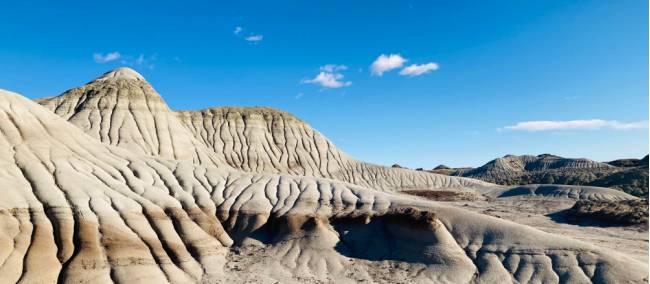
The stuning rock formations of the Canadian Badlands | Caroline Mongrain
There are places on Earth that make you feel like you’re on another planet, and there are places in Canada that make you feel like you’re nowhere else on Earth. Over millions of years, nature has fashioned unusual rocks, mounds, forests, lakes and hills. Encountering them on a hike or journey is always a highlight.
Hoodoos, AB

Hoodoos are 4- to 7-metre-high rock pillars that are synonymous with southern Alberta’s badlands. These unusual formations are created when soft sandstone is worn away by erosion, with harder rock remaining on the top, resulting in pillar-shaped columns of various shapes and sizes. Accompanied by local legends, you can spot hoodoos when visiting the dinosaur bone-rich Drumheller Valley.
Berry Head Sea Arch, NL

Berry Head is a striking rocky sea arch located on the Spurwink Island Path of the East Coast Trail. Perfect for postcards, it’s long been a highlight for hikers on the Avalon Peninsula. Unlike most sea arches, you can walk across and on top of this one, enjoying views of the sparkling Atlantic from every angle and keeping an eye out for juicy namesake berries.
Spotted Lake, Bc

I passed the sign for Spotted Lake several times before deciding one day to turn off the highway outside of Osoyoos and see what it actually was. Below a viewpoint sits a lake consisting of hundreds of circular pools, showing different colours caused by rich deposits of minerals like magnesium, sodium sulphate and calcium. It’s well worth the stop! Protected as a sacred site of healing by the Okanagan First Nation, visitors are not allowed to explore beyond the viewpoint.
Perce Rock, QC

Nature carved a hole in this dramatic limestone island off the coast of Gaspé, piercing an opening large enough to pilot a boat through. Alternatively, wait until low tide to stroll across a sandbar connected to the mainland. Either way, you’ll see thousands of sea birds safely nestled in the cliffs above, and marvel at this geological landmark of the Gulf of St. Lawrence.
Balancing Rock, NS

Some rocks are inexplicably poised on the edge of tipping over, daring a strong wind or clumsy push to finish the job. The most dramatic example can be found in St Mary’s Bay, where a 20-tonne basalt column is poised precariously above the Bay of Fundy. It can be accessed via the 1.7km Balancing Rock Trail, descending to a viewpoint via a 235-step wooden staircase. Visitors are often mesmerized, waiting for the gust that will finally topple the column over.
Pingos, NWT

Found in the Arctic regions of the planet, pingos are large, circular mounds of permafrost that resemble upside down tea-cups. Formed by the pressure of water on ice, the world’s largest concentration of pingos – some 1350 hills – are found at the Pingo National Landmark outside of Tuktoyaktuk. The largest pingo stands 70 metres high and 600 metres in diameter. You can’t walk on or near these sensitive environmental wonders, but you can access viewing areas or see them from above with a scenic flight.
Eve Cone, BC

Mount Edziza Provincial Park boasts the kind of striking volcanic landscape you’d expect in Iceland, not northwestern BC. Millions of years of eruptions have created basalt lava flows, desolate plateaus and perfect cones of burnt cinder. The most impressive of the so-called coffee craters is Eve Cone, which rises 150 metres above the plateau, resembling a giant blackhead on the face of the Earth. Remote Mount Edziza Provincial Park is accessed via air or several overland hikes.
Flowerpot Island, ON

Hikers on the Bruce Trail look forward to the boat ride from Tobermory to Flowerpot Island. Here, you’ll find an eastern shoreline with striking sea stacks, rock pillars and eroded caves. The unusual natural formations are caused by the seafloor eroding faster than the cliff face. Hikers can explore 4.3 kilometres of trails on the 200-hectare island and refresh with a swim in the crystal waters of Georgian Bay.
Western Brook Pond, NL

Glaciers carved out this stunning inland freshwater fjord on the west coast of Newfoundland. With its 600m rock walls and impressive waterfalls, the pond is the rock star highlight of the Gros Morne National Park and a UNESCO World Heritage Site. Visitors walk along a boardwalk trail over the boggy landscape and then typically take boat tours or hike to spectacular viewpoints.
Hopewell Rocks, NB

Canada’s best-known sea stacks are found on the shores of the Bay of Fundy. The world’s highest tides flush twice a day, rising to 16-metres high before draining out into the Atlantic. During low tide, visitors hike along the seafloor between the rock arches and flowerpots. Nature is constantly at work: the famous keyhole of Elephant Rock collapsed in 2016.
Robin Esrock is a renowned travel journalist and the bestselling author of the Great Canadian Bucket List.